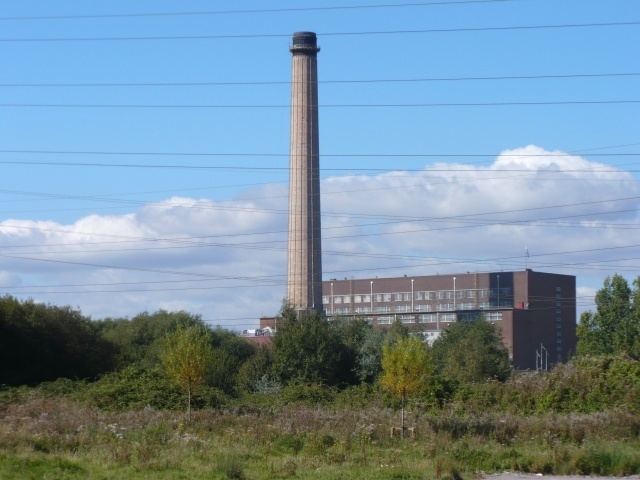Tertiary fuel Biomass Decommission date 1981 (A station) | Phone +44 1633 292700 | |
 | ||
Status A station: DemolishedB station: Operational Operator(s) Central Electricity Generating Board (1950s-1990)National Power (1990-1998)AES (1998-2003)Welsh Power (2004-09)Scottish and Southern Energy (2009-present) Nameplate capacity A station: 228 MWB station: 363 MW Hours Open today · Open 24 hoursMondayOpen 24 hoursTuesdayOpen 24 hoursWednesdayOpen 24 hoursThursdayOpen 24 hoursFridayOpen 24 hoursSaturdayOpen 24 hoursSundayOpen 24 hoursSuggest an edit Similar Ffestiniog Power Station, Dinorwig Power Station, West Usk Lighthouse, Swansea Barrage, Drax power station | ||
Uskmouth power stations viewed from newport wetlands
The Uskmouth power stations (also known as the Fifoots Point power stations) refers to a series of two coal-fired power station at the mouth of the River Usk in the south-east of Newport, Wales. The first of the two station, Uskmouth A power station, was built in the 1950s and demolished in the 1990s. The second station, Uskmouth B power station, was built in the 1960s.
Contents
- Uskmouth power stations viewed from newport wetlands
- Uskmouth AEdit
- Uskmouth BEdit
- Gas fired stationEdit
- Uses in cultureEdit
- References
Uskmouth AEdit
Uskmouth A power station was built and opened in the early 1950s. It was closed on 26 October 1981 with a generating capacity of 228 megawatts. The station was demolished in 2002
Uskmouth BEdit
Uskmouth B power station (or Uskmouth Power as it is now known) was built in 1959. It has a generating capacity of 363 MW, which is enough to power 360,000 homes, or the surrounding area of Newport. The electricity is provided by three generating sets. It is situated in an essential position for the National Grid, as there are very few power stations situated in the south of Wales. Initially operated by the Central Electricity Generating Board, the station's operations were handed over to National Power with privatisation in 1990. The station was then closed in 1995. But in 1998, it was purchased by AES. The station was given a £120 million refurbishment to bring it up to date with legislative requirements. New environmental equipment was installed and it was given a refurbishment which is thought to have extended the station's life by 25 years. The station's generating capacity was also increased to 393 MW. In 2001 the work was completed and the station was reopened. However, only a year later the plant passed into receivership, but had a brief period of operating in the winter between 2003 and 2004. In June 2004 the station was put back into full operation, when it was bought by Welsh Power, who were then known as Carron Energy. Welsh Power sold it to SSE (Scottish and Southern Energy plc) in 2009 for £27m. In April 2013 one of the three remaining blocks was closed, so the power station has now a remaining generation capacity of 260 MW.
The station is currently one of the cleanest coal-fired power stations in the United Kingdom, and is fitted with Flue Gas Desulphurisation equipment and low NOx burners. It also burns biomass, as well as coal, for its emissions to be considered closer to being carbon neutral. The station does not take water from or dump waste water into the River Usk. It instead uses secondary treated sewage water in its cooling system.
The station employs 90 people. It has been awarded RoSPA Gold Award for Occupational Health and Safety for its efforts to ensure station safety. The station's owners have participated in many local community projects – they donated land to the Newport Wetlands Reserve, and sponsor Welsh swimmer David Davies and the Newport Gwent Dragons.
The station has now been marked for closure
Gas-fired stationEdit
An 832 megawatt (MW) Combined Cycle Power Plant gas-fired power station has been built on the site of the A station by Siemens for Severn Power, a subsidiary of DONG Energy. It was initially reported that it would cost £400 million to build and create 650 construction jobs.
Severn Power Station comprises two gas turbines and two steam turbines each operating on a single shaft. The power station entered commercial operations in November 2010.
Originally owned and operated by the Danish company, Dong Energy, the station was acquired by MPF Holdings Limited in December 2013, which changed its name to Calon Energy in summer 2015.
Uses in cultureEdit
In 2006, the station was used as a location for two episodes of Doctor Who. In the episodes "Rise of the Cybermen" and "The Age of Steel", the station was used as the setting for the Cybermen Factory. It was then used again for the 2011 Christmas special "The Doctor, the Widow and the Wardrobe" as spaceship corridors, filmed on 20 September 2011. In 2014, the station was once again used for two episodes, respectively "Into the Dalek" and "Time Heist".
